Viva Cuba Exhibit
North South Studies, in its long tradition of solidarity with the South, traveled to Cuba this year. For three weeks we traveled through different parts of the island, learning about its history, economy, environment and culture. Conferences, field research and engagement with our Cuban hosts provided a new perspective, not only on Cuba but on the world. The VIVA CUBA exhibit is an expression of what we experienced and learned. Through the Integrative Seminar class, students and teacher explored academically and artistically these new perspectives. It is a celebration to the resilience of the Cuban people and our means of saying “thank you” for all you gave us.
North South Studies: Experiential Learning and Solidarity in Cuba
by Gisela Frias
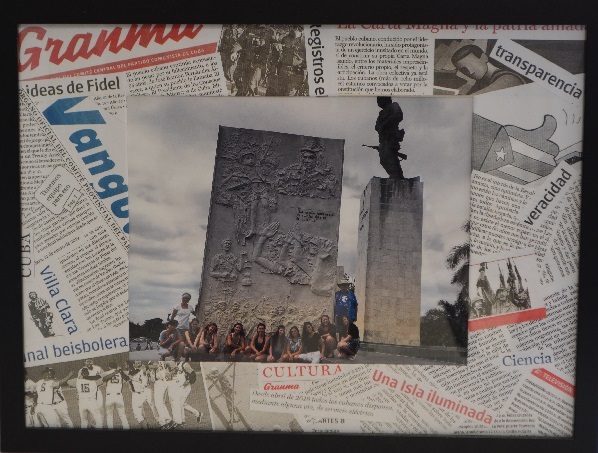 With rising global sociopolitical and environmental conflicts, institutions of higher education are called to offer educational programs that nurture global competence and citizenship. Experiential learning, learning by doing, has for long offered a pedagogy that promises more effective, engaging and embedded learning. International field trips have the potential of integrating important pedagogical tools of experiential learning to support the development of global citizenship and solidarity. This year’s North South Studies’ field trip to Cuba provided such opportunities. The trip was a hands-on learning experience of life in the South. Cuba was a teacher of numerous lessons, ranging from history to economics and ecology. Students and teachers were transformed through discovering Cuba, its struggles as well as all it has to teach us. It was itself a lesson on solidarity as it nurtured us in our own lives.
With rising global sociopolitical and environmental conflicts, institutions of higher education are called to offer educational programs that nurture global competence and citizenship. Experiential learning, learning by doing, has for long offered a pedagogy that promises more effective, engaging and embedded learning. International field trips have the potential of integrating important pedagogical tools of experiential learning to support the development of global citizenship and solidarity. This year’s North South Studies’ field trip to Cuba provided such opportunities. The trip was a hands-on learning experience of life in the South. Cuba was a teacher of numerous lessons, ranging from history to economics and ecology. Students and teachers were transformed through discovering Cuba, its struggles as well as all it has to teach us. It was itself a lesson on solidarity as it nurtured us in our own lives.
The words of Che Guevara “La arcilla fundamental de nuestra obra es la juventud” (The fundamental clay of our work is youth” serve as a background to a group picture of NSS. A collage made of headlines from Cuba’s newspapers during the time of our visit, serve to frame this picture as Cuba gave us a new frame of reference.
***
Echoes
by Isabella Gavanski, Mikayla Geraghty, Tatiana Gordoa, Catherine Howison, Amanda Kuflik, Georgia Lapierre, Elara Neath-Thomin, Anna-Rosa Percoco, and Frédérick Simard
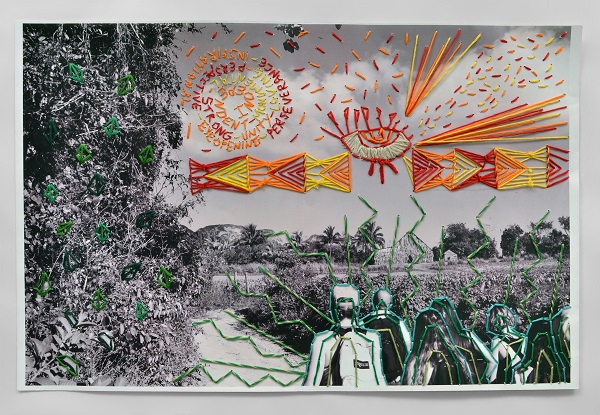 Unifying. Loving. Strengthening. Eye-opening. Inspiring.
Unifying. Loving. Strengthening. Eye-opening. Inspiring.
These are all words used by the students of North South Studies to describe one place—Cuba. When thinking of this country, these are typically not the first words that come to mind for many people. Some view Cuba as a dictatorship, and others see Cuba as the perfect tourist destination. While these perspectives aren’t necessarily right or wrong, it is important that we understand that there are multiple and complex sides of this country so rich in history and beauty. Told from our perspective as North-South students who recently visited Cuba, this piece hopes to show a different side to Cuba than the one that readily comes to mind.
In this audio recording, we express shared perspectives, such as the warmth and resilience of the Cuban people, juxtaposing them with our differing views, such as a critique of government control. The melody unifies and makes distinct many voices and thus vocalizes shared and individual perspectives. Each student looks within themselves to identify one word to describe their view of Cuba.
Within the photo, the embroidered bright reds, orange and yellows symbolize the colours of a sunset as we look toward the future: the end of one experience promising the beginning of new ones. The never-ending field of green string represents our presence in Cuba as well as the beautiful countryside itself. The artwork features a twisting of words to demonstrate the many perspectives held by each student. It is our hope that like the embroidered open eye looking at the unfolding scene, this piece will open viewers’ eyes to a different perspective on this highly debated country.
***
Paving The Road Through Education
by Isabella Gavanski
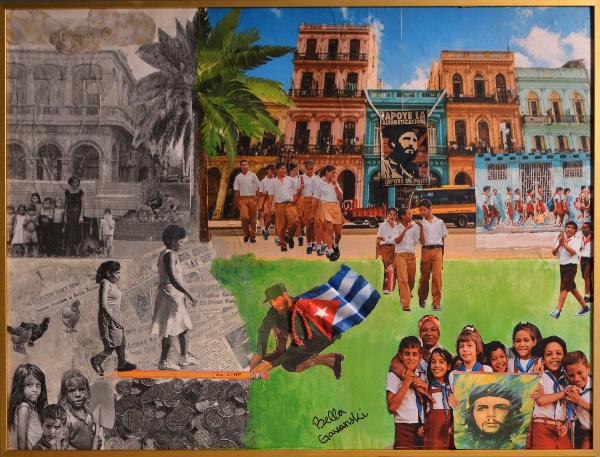
The communist Cuban government made it a goal after the revolution to provide education to its entire population no matter where they lived and their socio-economic status. In 1961 the Cuban revolutionary government aided by Armando Hart Davalos, then the Minister of Education, took a step to completely eradicate illiteracy throughout all of Cuba with the literacy campaign (Abendroth). Overall, the literacy campaign was a big success as 700,000 Cubans learned to read and write, causing the illiteracy rate to go down from 25% to 3% (Maestra). This movement involved over 100,000 Cuban youth under 18 and the majority of those involved were women (Maestra). It is mentioned in the literature that Cuba is the leading country within the developing world when it comes to education. Cuba was the first country in America to eradicate illiteracy (Alarcon de Quesada). The Cuban government has taken many other measures to ensure that students continue to have access to education today, including sending teachers to rural areas with only a few students. This program has helped many people' who would not have had the chance, to go to school, become educated and obtain professional jobs. This is primarily a good thing for the Cuban people. But it is also important to learn about the challenges. While interviewing a former Cuban teacher some of these were mentioned, including the fact that it is too expensive for the government to pay for everyone's education, and because everyone has a high level of education no one wants to do work in the countryside.
My art piece, Paving The Road Through Education, illustrates the value of education in the history and culture of Cuba. The black and white images show the widespread poverty in Cuba during the Batista regime, while the bright colours represent students walking freely in current day Cuba. The pencil represents a bridge from the past to the present and Castro/Cuba is somewhat of a superhero helping people cross the bridge using education to empower their people.
Works Cited
Abendroth, Mark. Rebel Literacy : Cuba’s National Literacy Campaign and Critical Global Citizenship. Litwin Books, LLC, 2009.
Maestra. Directed by Catherine Murphy, featuring Norma Guillard, and Diana Balboa Women Make Movies, 2011.
***
Love, Friendship and Creativity in Cuba
by Mikayla Geraghty
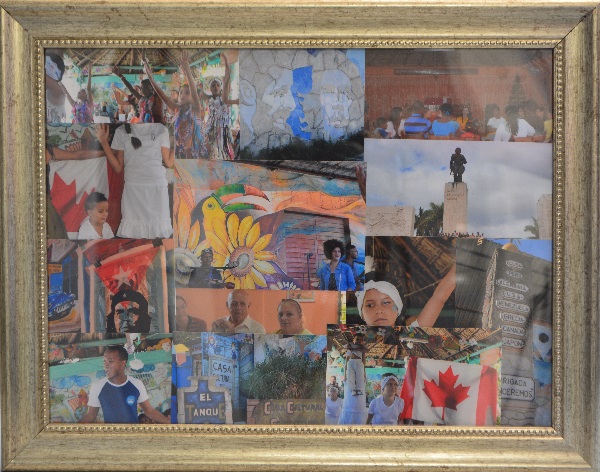 Creativity is one of the most important factors that contribute to a happy life. As one ages in the West, the importance of creativity is often pushed aside and instead exchanged for practical skills and arithmetic. The happiness from creating is one that is often overlooked in my own Western culture. However, throughout my journey in Cuba I discovered that while the Latin country may lack resources, it prospers in creativity, love and friendship, only a few of the factors that contribute to their culturally diverse country. Their love of art and the importance placed on culture has inspired me to invite more art and creativity into my own life. Upon deep reflection of what I saw in Cuba, I decided that I wanted my personal art piece to be centered around the people and their diverse culture in comparison to my own. The love and importance put on art and culture really touched me. Arts and culture hold up a unique torch in Cuba that I have not seen elsewhere. It is for that reason that for my art piece I wish to do a collage of all we saw and experienced in Cuba. To focus on the aspects that I felt held value in Cuba, which was art and the citizens. I hope that through my art piece I can display Cuba’s artistic innovation and diversity that I discovered during my brief time in the country.
Creativity is one of the most important factors that contribute to a happy life. As one ages in the West, the importance of creativity is often pushed aside and instead exchanged for practical skills and arithmetic. The happiness from creating is one that is often overlooked in my own Western culture. However, throughout my journey in Cuba I discovered that while the Latin country may lack resources, it prospers in creativity, love and friendship, only a few of the factors that contribute to their culturally diverse country. Their love of art and the importance placed on culture has inspired me to invite more art and creativity into my own life. Upon deep reflection of what I saw in Cuba, I decided that I wanted my personal art piece to be centered around the people and their diverse culture in comparison to my own. The love and importance put on art and culture really touched me. Arts and culture hold up a unique torch in Cuba that I have not seen elsewhere. It is for that reason that for my art piece I wish to do a collage of all we saw and experienced in Cuba. To focus on the aspects that I felt held value in Cuba, which was art and the citizens. I hope that through my art piece I can display Cuba’s artistic innovation and diversity that I discovered during my brief time in the country.
***
Images of Cuba
by Tatiana Gordoa
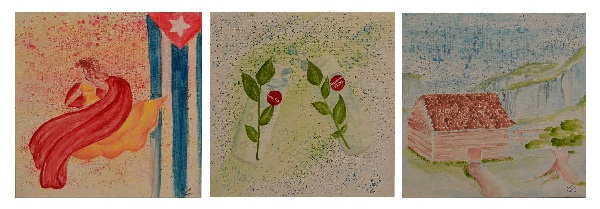 Tourism is an important sector in Cuba’s economy. In order to make other industries profitable, government owned companies have adapted their services to welcome tourists. This is the case of the famous tobacco industry. Many farms and cigar factories have opened their doors for foreigners to visit. Thousands of people from across the world, when visiting regions like Viñales, make a point of passing by a tobacco farm and drinking one of their signature mojitos. Through this practice, the farm earns more income to reinvest into itself, sustain its core purpose (in this case tobacco farming) and benefit its workers. Thus, tourism becomes a predominant industry in the island’s economy and sustains the livelihood of an important part of the population. Restaurants, due to the existence of the two different currencies in the country, mostly depend on the presence of foreigners in the country for subsistence. The Cuban Convertible Peso (CUC) has approximately the same value as the American dollar; however, the Cuban Peso’s (CUP) value is quite low. Twenty-five CUPs equal one CUC. Tourists have very limited access–if not no access–to the CUP. A foreigner, therefore, has far more purchasing power than a local.
Tourism is an important sector in Cuba’s economy. In order to make other industries profitable, government owned companies have adapted their services to welcome tourists. This is the case of the famous tobacco industry. Many farms and cigar factories have opened their doors for foreigners to visit. Thousands of people from across the world, when visiting regions like Viñales, make a point of passing by a tobacco farm and drinking one of their signature mojitos. Through this practice, the farm earns more income to reinvest into itself, sustain its core purpose (in this case tobacco farming) and benefit its workers. Thus, tourism becomes a predominant industry in the island’s economy and sustains the livelihood of an important part of the population. Restaurants, due to the existence of the two different currencies in the country, mostly depend on the presence of foreigners in the country for subsistence. The Cuban Convertible Peso (CUC) has approximately the same value as the American dollar; however, the Cuban Peso’s (CUP) value is quite low. Twenty-five CUPs equal one CUC. Tourists have very limited access–if not no access–to the CUP. A foreigner, therefore, has far more purchasing power than a local.
In a trilogy of paintings, I highlight different facets of Cuban tourism: dance and culture, the natural richness of the landscapes, and the mainstream resort-like Cuban experience. Each canvas has a main colour theme that suits the subject of the art.
***
The Economic Wall
by Catherine Howison
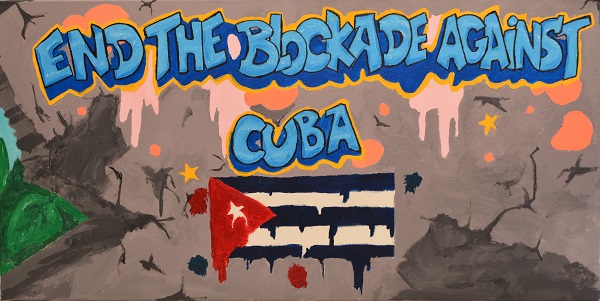 The US embargo issued against Cuba—the economic restrictions imposed on it—have been strangling this country for 60 years now. These restrictions have no other goal than to express the resentment of the U.S.A. when faced with a country that wants what is best for their people. I want people to be aware of the embargo in the hope that they will see how unfair it is. My project is an acrylic painting. When we were in Cuba we saw a bus with the words “End the blockade against Cuba” written in graffiti. I found this very inspiring and wished to recreate it in a painting where the same words would be painted on a crumbling wall, with a glimpse of the scenery behind it. In a way I see this wall as the Embargo itself, acting like an economic wall.
The US embargo issued against Cuba—the economic restrictions imposed on it—have been strangling this country for 60 years now. These restrictions have no other goal than to express the resentment of the U.S.A. when faced with a country that wants what is best for their people. I want people to be aware of the embargo in the hope that they will see how unfair it is. My project is an acrylic painting. When we were in Cuba we saw a bus with the words “End the blockade against Cuba” written in graffiti. I found this very inspiring and wished to recreate it in a painting where the same words would be painted on a crumbling wall, with a glimpse of the scenery behind it. In a way I see this wall as the Embargo itself, acting like an economic wall.
***
Tiles of Tourism
by Amanda Kuflik
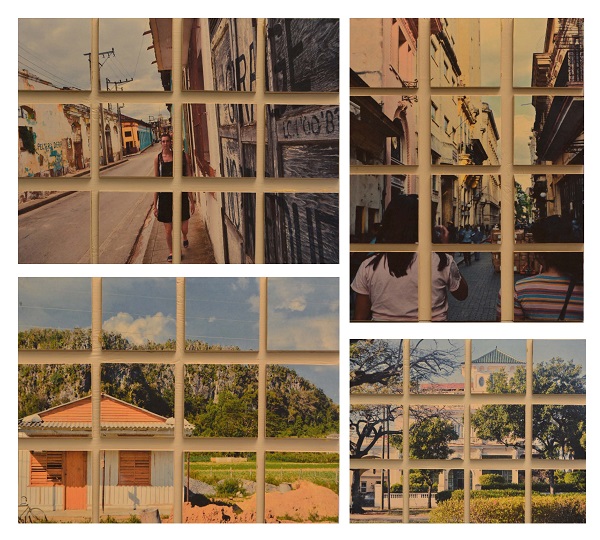 What is the first thing that comes to mind when you think of Cuba? Is it the beautiful beaches and crystal-clear water of the Caribbean? The classic 1950s American cars driving through the streets of Havana? Or is it the rich colonial history and architecture found throughout the country? These are romanticized versions of the Cuban reality.
What is the first thing that comes to mind when you think of Cuba? Is it the beautiful beaches and crystal-clear water of the Caribbean? The classic 1950s American cars driving through the streets of Havana? Or is it the rich colonial history and architecture found throughout the country? These are romanticized versions of the Cuban reality.
While tourism is an important part of the Cuban economy, it has created a problematic social divide known as tourist apartheid (Bleasdale). This divide is seen between tourists and Cubans, as well as among Cubans, creating divisions them, between those who have access to the more valuable tourist dollar, and those who do not (Bleasdale). Through this project, I aim to show the differences I witnessed between Cubans working in the tourism industry versus those who are not. I present four framed photographs representing these differences. Two of the photographs are from two different neighbourhoods in Havana. The other two photographs show the difference between Viñales, a very popular tourist destination in the mountains, and Puerto Esperanza, a small Cuban village less than an hour outside of Viñales that barely receives any tourists.
Works Cited
Bleasdale, Sue, and Sue Tapsell. “Chapter 9: Matching Sustainable Tourism with Socialist Goals: Can Cuba Have It All?” Resources, Planning and Environmental Management in a Changing Caribbean, 2003, pp.173-195.
***
The Colours of Employment
by Georgia LaPierre
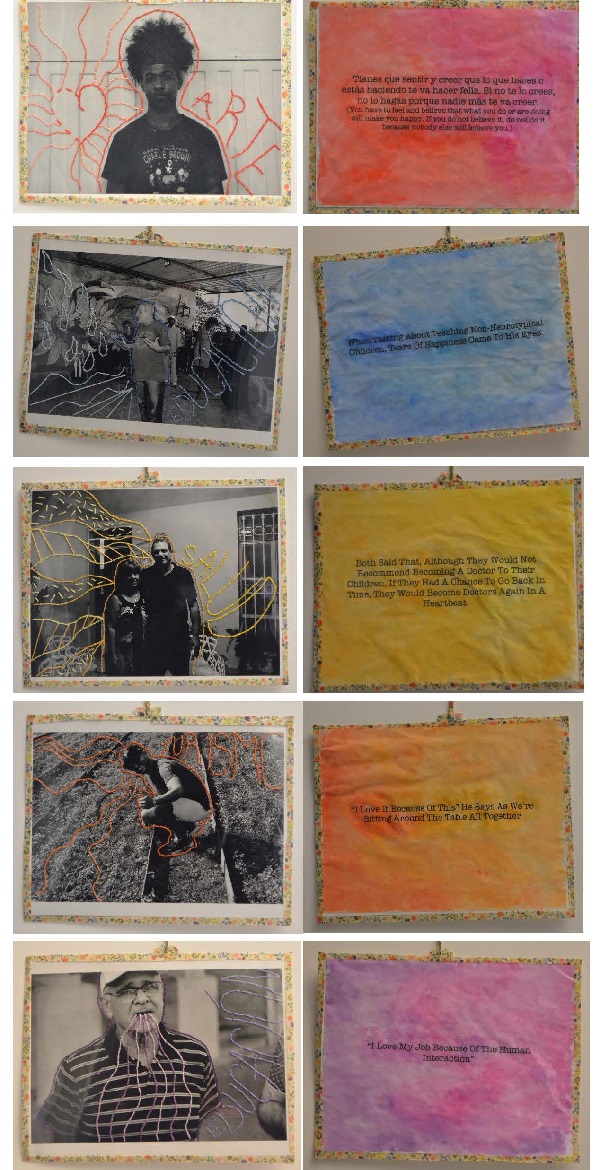 White, a well-being scholar, tells us that “Well-being is not simply about ‘the good life’ but ‘living the good life’” (160). Our employment experience and income have been identified as crucial components of ‘living the good life’. However, Shwanen et al. and White argue that an individual’s actual experience and thoughts on their job are the most important factors to consider when discussing well-being (White 160; Shwanen et al. 98). For this reason, my field research in Cuba focused on individual experiences. My overall findings were that Cubans, while they have what can be considered a low income, enjoy their jobs and have a positive, happy outlook on life. This positive outlook on their employment seems mainly to be due to feeling that they are contributing to their society.
White, a well-being scholar, tells us that “Well-being is not simply about ‘the good life’ but ‘living the good life’” (160). Our employment experience and income have been identified as crucial components of ‘living the good life’. However, Shwanen et al. and White argue that an individual’s actual experience and thoughts on their job are the most important factors to consider when discussing well-being (White 160; Shwanen et al. 98). For this reason, my field research in Cuba focused on individual experiences. My overall findings were that Cubans, while they have what can be considered a low income, enjoy their jobs and have a positive, happy outlook on life. This positive outlook on their employment seems mainly to be due to feeling that they are contributing to their society.
The artistic expression of this project is a series of photos that were taken in Cuba of the people that I interviewed on the trip. I have embroidered these photos with a variety of designs, and I chose the colours in order to represent the feeling that these Cubans expressed towards their jobs. I have also embroidered the name of the field in which they work. I have also included a quote from their interview that I believe encaptures their overall feeling towards their jobs, and why they continue to work in this domain.
Works Cited
White, Sarah C. “Analysing Wellbeing: A Framework for Development Practice.” Development in Practice, vol. 20, no. 2, 2010, p. 158.
Schwanen, Tim, and Sarah Atkinson. “Geographies of Wellbeing: An Introduction.” The Geographical Journal, no. 2, 2015, p. 98.
***
Harvesting Victory (You Reap What You Sow)
by Elara Neath Thomin
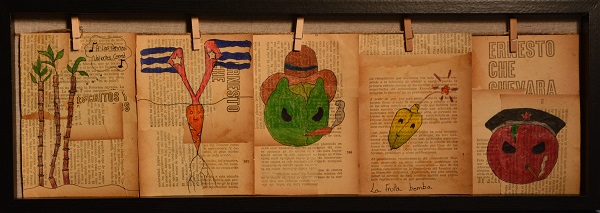 Sowing urban sources of food is a revolutionary act. Since food is one of the key necessities of life, producing enough of it to satisfy one’s own needs is a promise of independence, for one person or for an entire people. This has been proven time and time throughout history, and is well symbolized by the Cuban’s people quest for their own independence. Amidst the turmoil of the Special Period, Cuba invested part of its resources in organic agriculture to ensure some degree of food security within the country. Part of this effort took the shape of urban agriculture, which became a symbol of resistance and innovation on behalf of the Cuban people. This was particularly clear through the works by Premat, who highlights the Cuban government’s efforts to present gardening as a revolutionary effort. To this effect, they used the slogan “Sí se puede” (Neath Thomin 4), which echoes the well-known “We can do it!” slogan that was targeted to women during the Second World War. Both share the same bold energy, the same enticing invitation. Cuba is not the first country to use urban gardening as part of a resistance efforts either: one can think for example of the British Victory Gardens during World War II. Above all, I love the apparent contradiction of using an act of peace to survive (or sustain) a war, in the idea that nurturing a garden can be a way to fight back, and so this is what I explore through this project.
Sowing urban sources of food is a revolutionary act. Since food is one of the key necessities of life, producing enough of it to satisfy one’s own needs is a promise of independence, for one person or for an entire people. This has been proven time and time throughout history, and is well symbolized by the Cuban’s people quest for their own independence. Amidst the turmoil of the Special Period, Cuba invested part of its resources in organic agriculture to ensure some degree of food security within the country. Part of this effort took the shape of urban agriculture, which became a symbol of resistance and innovation on behalf of the Cuban people. This was particularly clear through the works by Premat, who highlights the Cuban government’s efforts to present gardening as a revolutionary effort. To this effect, they used the slogan “Sí se puede” (Neath Thomin 4), which echoes the well-known “We can do it!” slogan that was targeted to women during the Second World War. Both share the same bold energy, the same enticing invitation. Cuba is not the first country to use urban gardening as part of a resistance efforts either: one can think for example of the British Victory Gardens during World War II. Above all, I love the apparent contradiction of using an act of peace to survive (or sustain) a war, in the idea that nurturing a garden can be a way to fight back, and so this is what I explore through this project.
I created a series of cartoonish sketches presenting some personified vegetables and fruits as revolutionary figures. These do not necessarily represent combatants per say, but rather important symbols of the Revolution as perceived by Cubans. I saw this as a humoristic way to pay my respects to all those who fight to keep Cuba fed and free.
Works Cited
Neath Thomin, Elara. “Literature Review.” Dawson College Omnivox, Dec. 2018.
***
Hasta la última gota de sangre / Until the last drop of blood
by Rosie Percoco
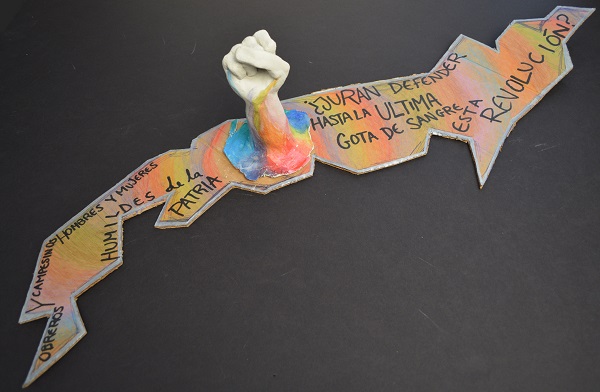 “Obreros y campesinos, hombres y mujeres humildes de la Patria ¿Juran defender hasta la última gota de sangre esta Revolución de los humildes, por los humildes y para los humildes?:”
“Obreros y campesinos, hombres y mujeres humildes de la Patria ¿Juran defender hasta la última gota de sangre esta Revolución de los humildes, por los humildes y para los humildes?:”
- Fidel Castro
Following the Cuban revolution, the CIA began using anti-revolutionary organizations and training Cuban exiles in neighboring countries for covert operations in Cuba. This was in preparation for the Bay of Pigs invasion which planned to overthrow Castro by “invad[ing] the island and install[ing] a new, more compliant pro-American government” (Sweig, 79). The strong association Cubans felt to the revolution helped them resist the invasion and “rallied wavering middle-class Cubans to defend Cuba” (Cockcroft, 303). The unity within the “obreros” (labourers) and “campesinos” (peasants) emerged from their desire to protect the ideology which liberated their country.
With my art piece, I embody the unity, perseverance and strength of the Cuban people when standing against the invading powers. This piece represents Fidel’s ability to inspire, empower and guide Cuban civilians. Never surrendering, they were willing to give their lives to defend the socialist revolution.
Works Cited
Cockcroft, J. D. 1996. Latin America: History, Politics, and U.S. Policy. Second Edition. Belmont CA. Wadsworth Publishing. Print.
Sweig, J. E. 2009. Cuba: What everyone needs to know. New York. Oxford University Press. eBook.
***
El cocodrilo
by Frédérique Simard
“Hasta la Victoria Siempre” (Always until Victory) is the bold statement displayed under the 20 ton bronze statue of Che Guevara in Santa Clara, and it represents well the never-ending battle towards freedom that Cubans have been fighting for centuries. Cuban history is complex and fascinating at the same time. Indeed, the values and principles that have developed through the years of the Cuban revolution are inspiring and unfortunately not often well understood outside of the island. To help share these values and principles, I am expressing, through a poem, the perseverance, resilience, and courage of the Cuban people throughout their history through the metaphor of a crocodile. I draw similarities between the crocodile’s ferocious personality and the Cuban people’s determination to reach freedom, while its known enemy, the hippopotamus, represents the United States. Moreover, the Cuban island is itself known as “El Cocodrilo” since it is both in the shape of a crocodile and a hub for crocodiles. My main sources of inspiration are my notes taken in both my journal and cuaderno during our visits to the Che Guevara memorial monument, the museum of the Revolution, as well as the museum of the Bay of Pigs. The message I would like to transmit is how we could all learn a little from Cuba, specifically from the perseverance of its people, as well as their strong “joie de vivre”, that led to their bold sense of belonging and solidarity today.
El Cocodrilo
Cuban history is no mystery,
But it does revolve around complexity.
Following its evolution from slavery to solidarity
Let me express the infamous story of the Cuban island
Known as “el cocodrilo”.
A crocodile is resting under the warm sun of the Caribbean.
It is paradise on Earth:
Golden beaches, golden sunsets
And golden natural resources,
which make it a treasured island.
As soon as it is discovered,
Slavery settles in and the crocodile is imprisoned.
The crocodile shows its teeth in hope that it will break free from colonization,
Yet it is too weak.
Its only choice is to turn to the powerful Hippo up North.
But you know what they say about hippos and crocodiles,
They are not friends, nor are they enemies:
It’s a mutual tolerance, so it can lead to destruction.
The crocodile may be small and fragile compared to the hippo,
But its ferocious blood and communal strength is key to its success.
The hunt for independence was a challenge,
But the crocodile managed to outsmart the hippo
By following the red star on the General’s hat and
by staying “fidel” (loyal) to the revolutionary leader.
Breaking free from colonialism demanded courage and determination,
Yet daily economic obstacles demand even more dedication.
Regardless, the mix of resilience and joie de vivre sprinkled in the Cubans’ hearts
Is the living example that peace amongst individuals
who make most of the little that they have,
is more than possible.
***

Comments
Kamilia Heddache
September 3, 2020This is by far my favorite SPACE exhibit (this is obviously a quite biased opinion given that I am myself a North-South Studies student who went to Cuba for field research). The art-work that I found particularly interesting is Amanda Kuflik’s “Tiles of Tourism”. Not only are the tiles absolutely gorgeous, they bring me back to a conflicting feeling that I have experienced throughout my field research in Cuba. After spending an entire year learning about Cuba’s history, I was very aware of the effects of tourism on the island; the positive and the negative ones. I understand the fact that Cuba relies on tourism to survive and that telling people that they shouldn’t travel to Cuba and stay in fancy hotels while eating fancy food is a little self-defeating. However, I am also aware of the scarcity of certain resources on the island and, while doing my research, it felt quite unsettling to eat certain foods or to enjoy certain luxuries while knowing that most Cubans did not have access to them specifically because of the tourism industry.
You have to be registered and logged in in order to post comments!